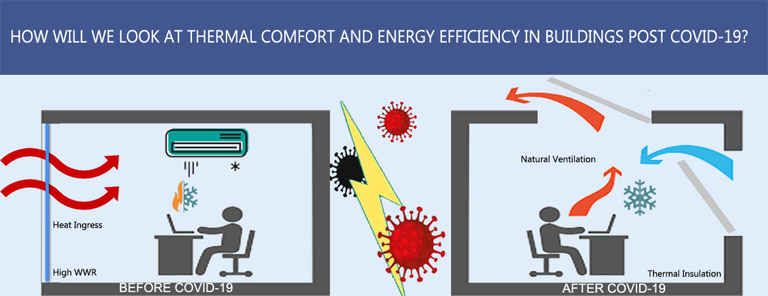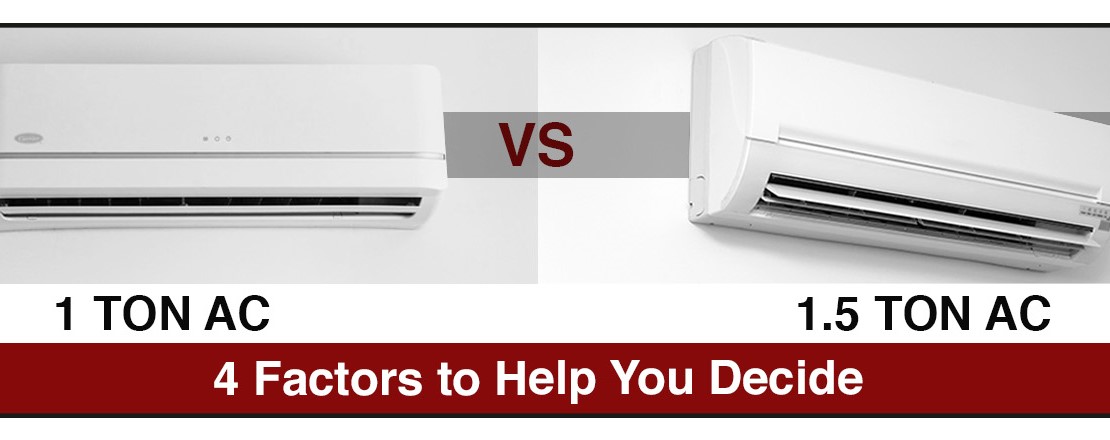
- Posted On: May 12, 2020
The COVID-19 pandemic has led to many discussions on all aspects and scales of our life- from the immediate concern of health, getting the “essentials”, loss of livelihood to broader socio-economic, infrastructure, design and planning issues.
Working in the field of building design and energy efficiency, added to the fact that the scorching summer of north India is upon us and that we are in a lockdown, made me think:
(A) How will I cope with the heat if my air-conditioner and cooler are not in working condition, considering that getting repairs done will not only be difficult now, but possibly also dangerous?
Living in an apartment with concrete walls makes me near obsessive about how hot my home would get. In April 2019 I finally made the move to a first floor flat, in the same apartment complex, from a top floor flat where I spent 5 years with torturous summers. My new apartment feels relatively cooler, and Delhi hasn’t yet reached the heights of temperatures that it usually reaches around this time (another effect of the lockdown, perhaps?). However, this begs the question: “what if we don’t have access to artificial cooling”? A home that is designed to provide optimum thermal comfort, without resorting to artificial cooling, becomes more relevant. When talking of buildings, especially homes, optimum thermal comfort through the building envelope IS an essential and should be non-negotiable.
(B) How will we operate our buildings in the pandemic? How will we operate them after this is over?
There have been multiple discussions and ideas about this on various platforms. The key point that everybody agrees on is to ventilate indoor environment with outdoor air as much as possible and to reduce recirculation and mixing, depending on the control that can be exerted on occupant entry (Healthcare facilities will have more stringent measures). ISHRAE has come up with a COVID-19 guidance document for Air-conditioning and Ventilation (https://ishrae.in/). Ventilation with only fresh air is the main recommendation. While minimum fresh-air requirements for HVAC were present before, in many air-conditioned buildings this was not provided for separately, assuming that opening and closing of doors and infiltration will take care of this. Now that the fresh air recommended is much higher, this will need to be actively designed.
In residences and mixed mode buildings, people should turn to natural ventilation through opening of windows as the first measure for cooling instead of turning on their ACs. Even when ACs are turned on, the ISHRAE document recommends keeping a window slightly open for fresh air intake. In hot-dry climate, use of evaporative coolers (installed in windows and not inside the room) is recommended as a better option which will enable cooling, ventilation and maintain relative humidity within the recommended 40-70%.
India’s total electricity consumption reduced by nearly 25% in March-April 2020 in comparison to the same months in 2019. However, there is an obvious increase in the domestic consumption. I assume, in homes that have ACs, their usage will be minimal due to a general understanding that it’s unadvisable to use them now. Even when they are used, whether in homes or commercial buildings, windows will be kept open simultaneously, which is otherwise usually not advised.
As an immediate knee-jerk reaction to the pandemic, once lockdown measures are relaxed, fully-conditioned buildings may have increased energy consumption due to the fact that mixing of return air and fresh air is not recommended. This may mean higher energy consumption to cool the fresh air. However, set-point temperature recommendations are also higher for COVID-19, and one hopes that they will be adhered to.
(C) How will we design our new buildings after the pandemic and will energy efficiency still remain relevant?
Designing better building design and envelopes and designing for improved natural ventilation must gain priority, especially in residential buildings and other mixed-mode buildings. One just cannot afford building a house without any thought to heat ingress, ventilation and daylight and slap-on an AC later. While we can bemoan the lack of outdoor spaces, courtyards etc., the fact remains that over the last couple decades our cities have not been planned to afford these to everyone.
As we slowly recover from this extreme event and return to normalcy, one can expect design of HVAC systems to undergo a change with due importance given to fresh air requirements.
The way we use and occupy our buildings may change. A lot of discussion on urban residential densities is already happening. This will be extended to the building scale. Open-plan offices and densities in our commercial buildings will be re-thought with higher space standards per occupant to enable social distancing. Automation and smart systems are also anticipated in buildings to avoid touching surfaces. Large projects like airports, transport stations, stadia etc. may be designed to be more flexible to cater to future crises. This will all have an impact on energy consumption.
As to whether energy efficiency will still remain relevant, I think it will, if we don’t relent to economic arguments of the pre-COVID time. An article1 on the impact of the lockdown on power consumption in India states stated:
“…..Besides, lower commercial and industrial demand, the relatively cool weather during April this year played spoil sport. The temperature remained below 40 degree celsius even in the second half of the month. The cool weather kept the power demand low despite partial easing of the lockdown from April 2020…..”
Here I was, cooped up at home, thanking the weather gods for the cool weather- and I see it being referred to as “spoilsport”!!! It is funny….but also quite telling of the current opposing priorities of the environment / climate change and restarting the economy. There are no easy, finite answers. But in hindsight what will be remembered is that during these tough months, the weather was cooler, air quality was way better, and that the environment was slowly changing course toward recovery. We were able to glimpse “What Could Be”…and it will be a real shame if we let it all go.
1 https://www.moneycontrol.com/news/business/economy/covid-19-lockdown-pulls-down-power-consumption-by-22-75-to-85-05-bu-in-april-5220541.html
Disclaimer: The views, thoughts, and opinions expressed in the above blog are the author’s own, and does not necessarily reflect that of Indo-Swiss BEEP, GKSPL or other group or individual.
-
- Saswati Chetia






